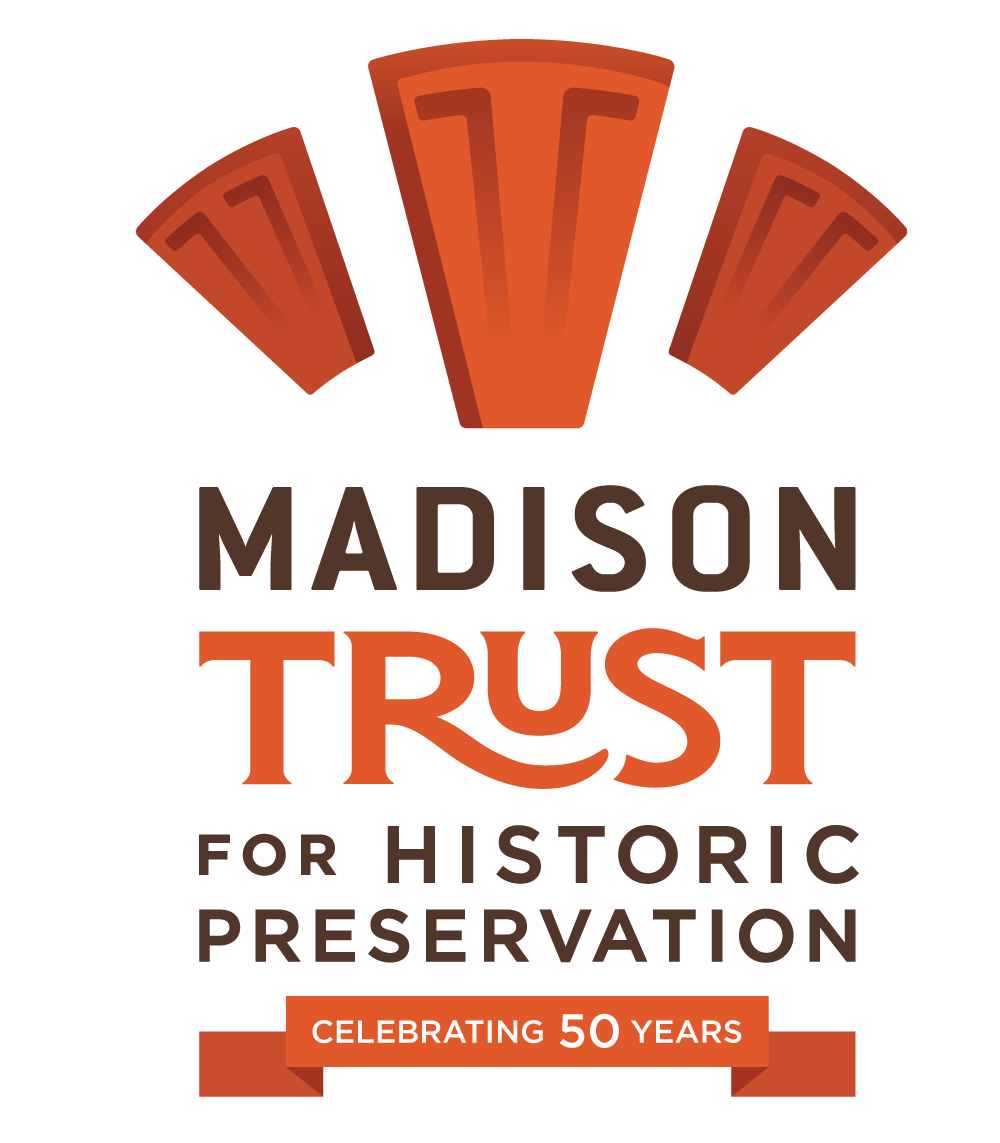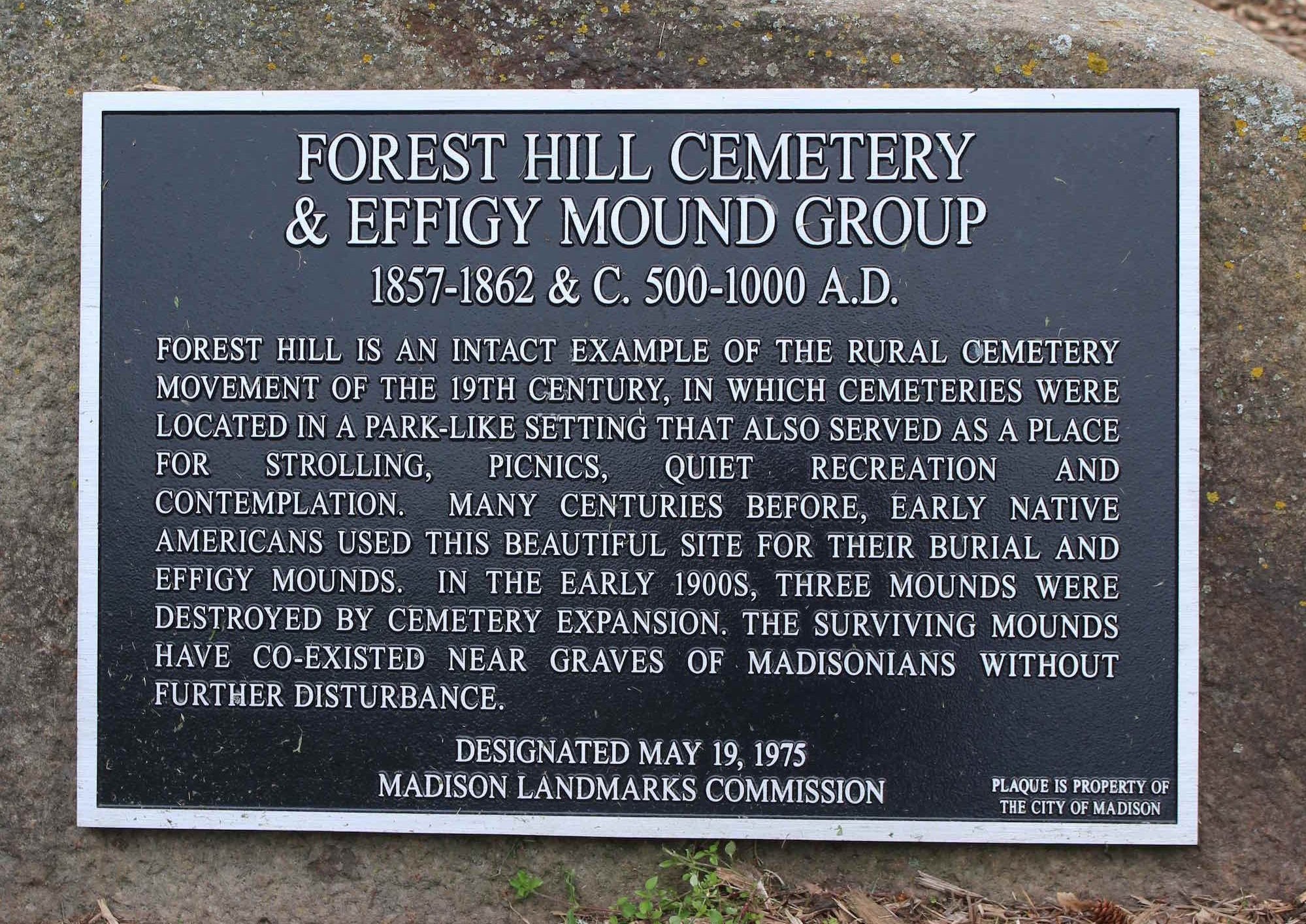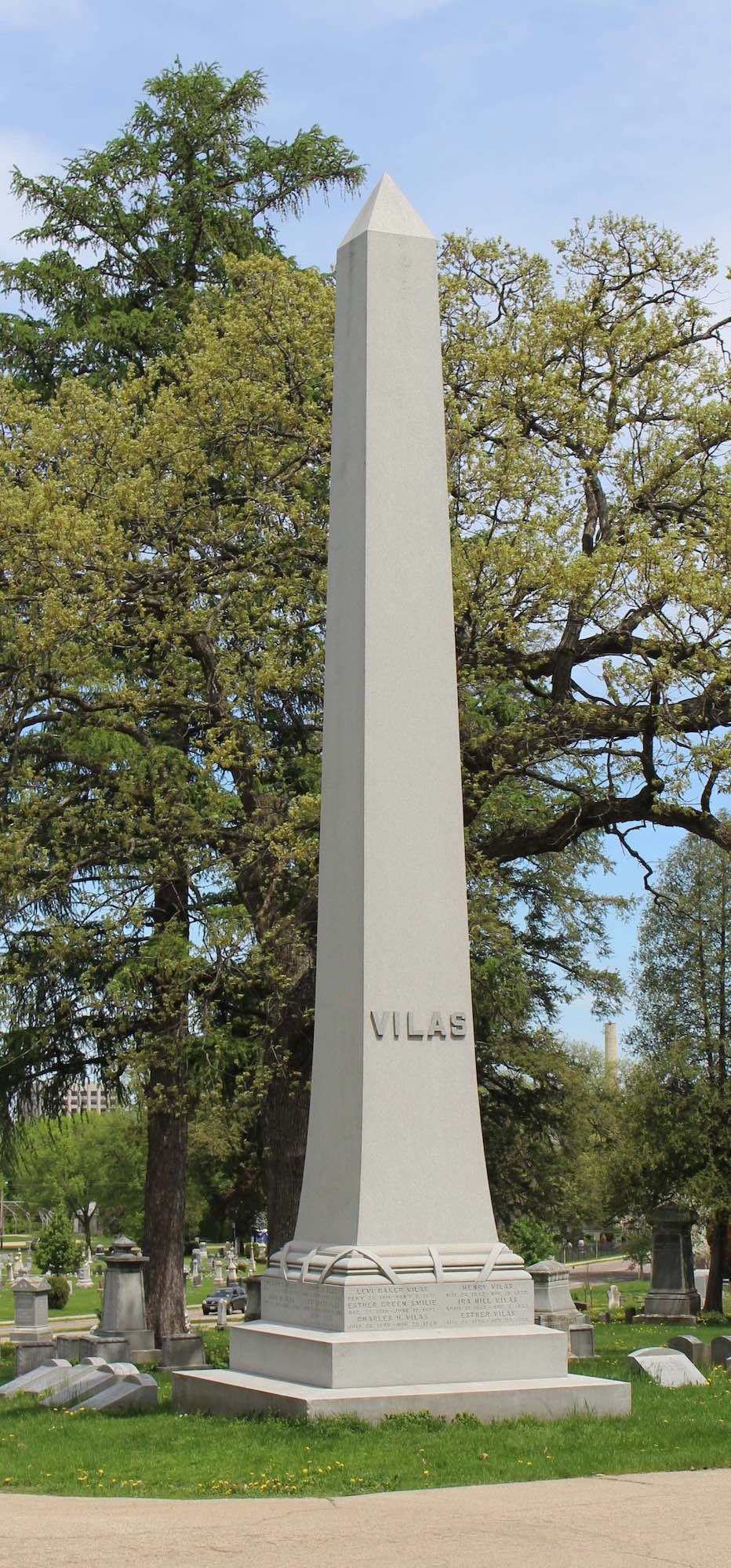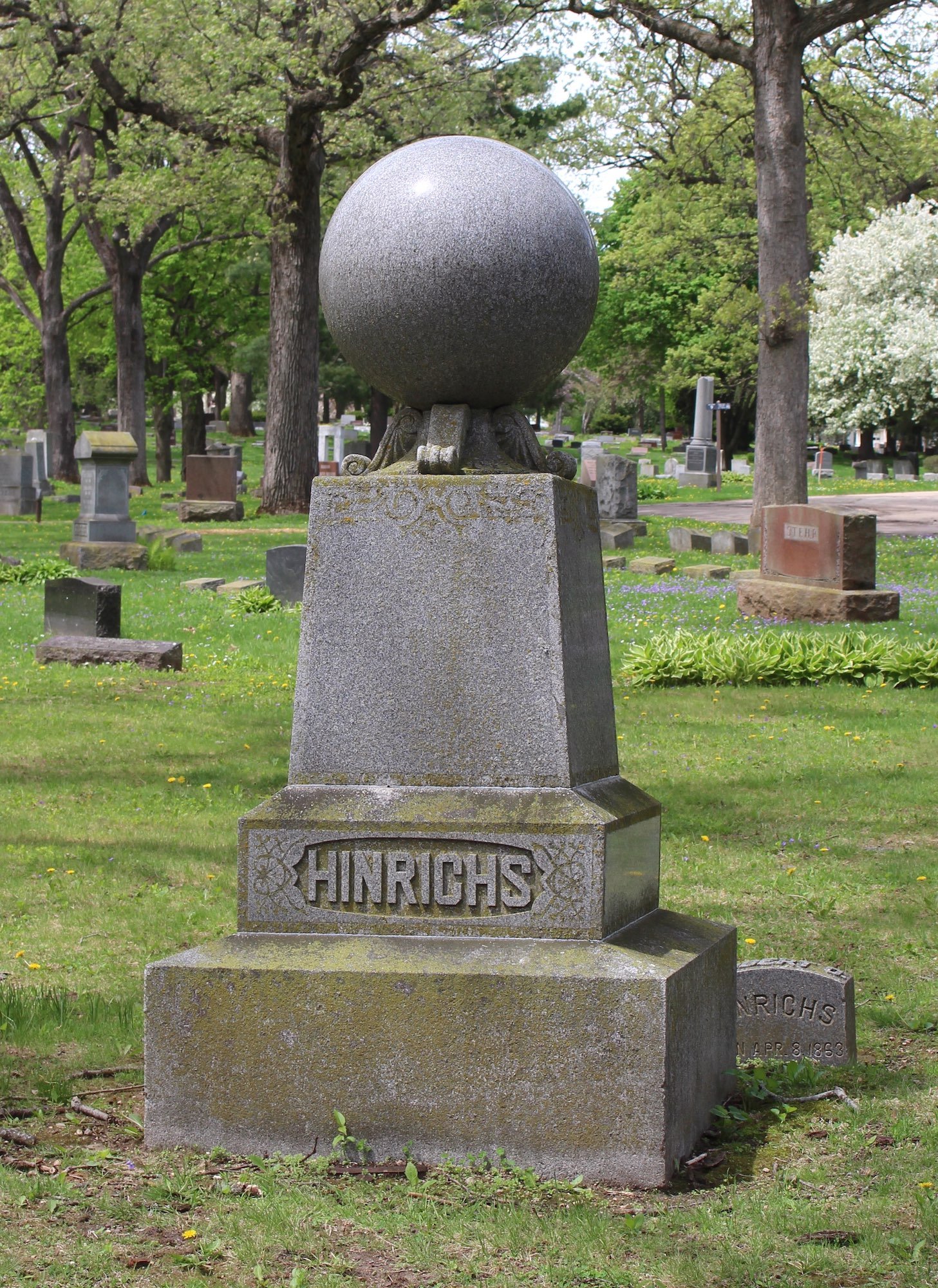Strolling at Forest Hill Cemetery
by Michael Bridgeman
There was a time, before public parks were commonplace, when Americans would routinely visit cemeteries as picturesque retreats. This was especially true of so-called rural cemeteries that became popular in the 19th century.
Forest Hill Cemetery on Madison’s west side was created as a rural cemetery. Centuries earlier, Native Americans used the site for burials and effigy mounds, some of which remain (above left). In 1897, streetcar tracks reached the entrance to Forest Hill Cemetery (above right). Public transit made it easier for citizens of all kinds to enjoy the quiet beauty of the grounds.
In the spirit of our ancestors, I recently took a leisurely walk through Forest Hill Cemetery, paying special attention to the design of gravestones, which don’t usually get much attention when we think of the built environment. Yet the ways we mark places for the dead, whether conventional or unusual, are devised very intentionally. My choices below are admittedly idiosyncratic and, the next time I visit Forest Hill, different markers might catch my eye.
For the most part, I don’t focus on the landscape, the history of the cemetery, or details about those who are interred. You can explore resources listed at the end of this post for more on these topics. For each grave marker pictured, I’ve provided the Section number where it is located. You can also click any image below to view in full screen.
Forest Hill map
. . .
Obelisks
“The obelisk is the most common monument found in nineteenth-century cemeteries,” according to The Archaeology of American Cemeteries and Gravemarkers. The obelisk dates to ancient Egypt and is a phallic symbol of fertility, representing eternal life. Earlier generations were better schooled on graveyard symbolism than we are today, but obelisks are impressive in themselves. Given when Forest Hill was established, it is home to many obelisks, from modest side-by-side shafts to the imposing 32-foot high obelisk that marks the Vilas family gravesite. Levi Vilas, a New England Yankee, enjoyed great success upon moving to moved Madison in 1851 and established something of a local dynasty.
Spheres
A sphere is a fundamental shape that can represent the unending circle of life. Though spheres look like they might easily topple and roll away, the two spheres that caught my eye haven’t gone anywhere for more than 100 years. One is atop a marker for the Hinrichs family and another is for Daniel Kent Tenney, an attorney and eponym of Tenney Park.
Temple
The temple form of Romanzo Bunn’s grave marker is not common at Forest Hill, at least not along the irregular path that I took through the grounds. Four Tuscan columns support an unornamented entablature over a symbolic urn in bronze. Compared to grand Neoclassical temples I’ve seen at other cemeteries, Bunn’s is unpretentious.
Romanzo Bunn’s grave (Sec. 34)
Rocks
While most cemetery markers are fashioned from stone, usually marble or granite, some show their “stone-ness” more than others. The Bird family has a large, seemingly raw boulder with only a carved panel etched with the names of those buried here. The Smith gravestone is much smaller, with a single undressed edge. It’s in the Jewish section of the cemetery, which is concentrated in western sections (38, 36 and 10). Forest Hill also has a section for Hmong burials, though Hmong markers are found throughout the graveyard.
Metals
A range of materials have been used for grave markers—including ceramic, terra cotta and concrete as well as cast iron and bronze—often for their malleability and (sometimes) lower cost. The monument for Francis Ogden was cast in zinc, giving it a bluish tinge. The marker has a portrait on one side and sounds hollow when tapped. Zinc was used in the decades around the turn of the twentieth century.
The Ogden marker (Sec. 27)
Columns
Traditionally a broken column symbolizes an unfinished life. These two broken columns mark the burials of brothers Leopold and John Lathrop, both of whom died in their early twenties in the 1850s. There are Art Deco influences in the tall marker for the Hommel plot with its three fluted shafts topped with a sharply angled capstone.
Modern: Vertical
The gravestone I remember best from earlier visits to Forest Hill is for the Elvehjems. It is distinctly modern in form and detail, including the low relief panel representing Conrad Elvehjem’s life and work as an educator and administrator at UW-Madison. Looking through my photos after my walk, I clearly like vertical stones from the mid-twentieth century. Another is the Kramer marker with a form and massing that remind me of a modernist skyscraper.
Modern: Horizontal
Twentieth-century markers can also be low and horizontal, not unlike traditional gravestones. Their simple forms and ornament identify them as modern, as with the Horner stone with its low, flat anchor slabs at either end. The Hall marker creates a flat arch over a carved stone urn and, in a way, recalls the temple form for Romanzo Bunn that we saw above.
Military Markers
Military cemeteries have a power all their own. There are two at Forest Hill, one for Union solders and the other for Confederates who died at Camp Randall (below left), which has been the subject of recent controversy. There are 240 Union soldiers buried in the Soldiers Lot at the west end of the cemetery. Veterans from more recent wars are buried around the mounds in Section 35 (below right). Forest Hill is now closed to military burials.
Learn More
Forest Hill Cemetery: A Guide is the richest resource about the west side burial ground. The website was created in 2015 by students enrolled in a methods seminar taught by Prof. Bill Cronon at UW-Madison. Among the many topics are history, landscaping, and effigy mounds.
There is a brief history Forest Hill on the Historic Madison Inc. website. Details on those who are buried there can be found in HMI’s A Biographical Guide to Forest Hill Cemetery. The two-volume guide is no longer for sale, but can be found at local libraries and, sometimes, in used bookstores.
Forest Hill Cemetery is owned and operated by the City of Madison and the Parks Division website has information on the graveyard with links for searching burial records and planning a walking tour. There’s also a phone number for inquiries about burial plots.
Gravely Speaking is a blog that covers a wide range of topics about graves, gravestones and graveyards. The blog is searchable and has plenty of photos.
A book I found most useful is The Archaeology of American Cemeteries and Gravemarkers by Sherene Baugher and Richard F. Veit. Lots of books emphasize early gravesites that pre-date Madison settlement. This book, available at the Wisconsin Historical Society Library, ventures into the twenty-first century.
Image Credits
Streetcar at Forest Hill entrance. Postcard published by E.A. Bishop, Racine, Wis., undated. Collection of author.
Forest Hill map. Forest Hill Cemetery: A Guide, http://foresthill.williamcronon.net/maps/
Confederate Rest. Forest Hill Cemetery: A Guide, http://foresthill.williamcronon.net/. Photo by William Cronon.
All other photos by Michael Bridgeman.
















